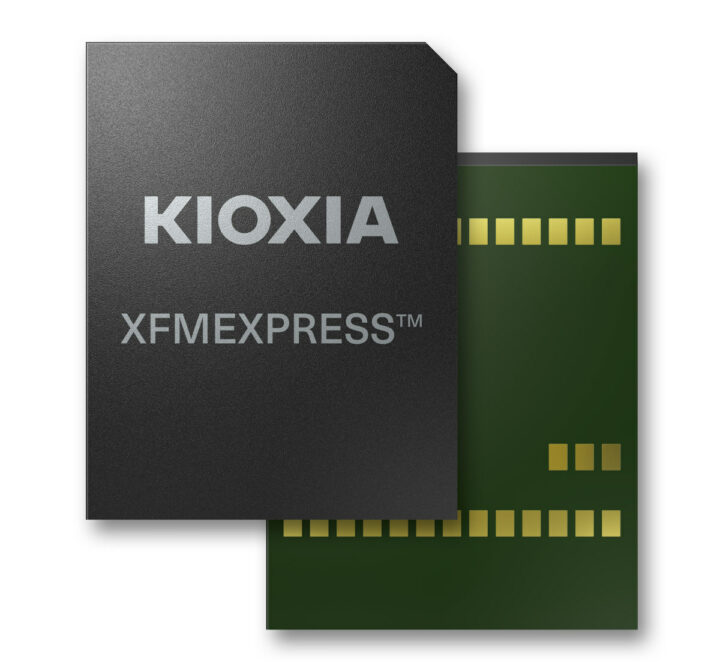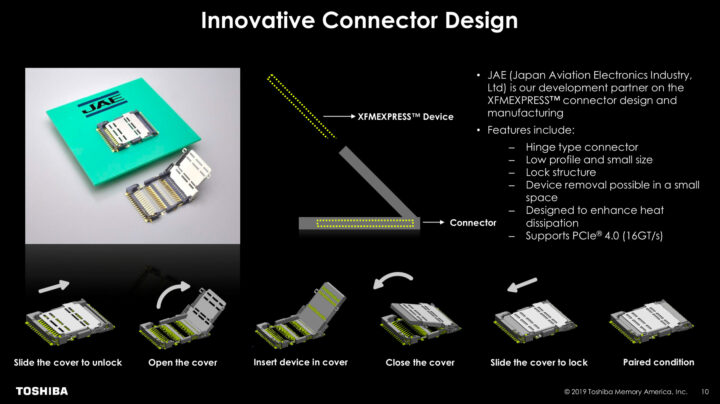KIOXIA Corporation, previously known as, Toshiba Memory Corporation, has started sampling of the XFMEXPRESS XT2 removable PCIe/NVMe storage device compliant with XFM DEVICE Ver.1.0-standard with dimensions of just 18×14 mm.
The new storage standard and device are mostly designed for space-constrained applications ranging from ultra-mobile PCs to IoT devices and various embedded applications that may require fast, removable storage.
 We do not have the full specifications for the XFMEXPRESS XT2, but here are the highlights:
We do not have the full specifications for the XFMEXPRESS XT2, but here are the highlights:
- Host interface – PCIe 4.0 x 2 lanes, NVMe 1.4b interface with similar performance to M.2 SSDs
- Removable storage similar to microSD card
- Dimensions
- 18 x 14 x 1.4mm (252 mm2 footprint) compliant with JEDEC XFM DEVICE Ver.1.0 form factor
- 22.2 x 17.75 x 2.2mm when considering the drive & connector
As I understand, the new storage device is meant to deliver much higher performance than microSD cards, while providing a thinner and smaller form factor than M.2 SSDs. combining the best of both worlds. KIOXIA first announced it in 2019, when it was still called Toshiba, but it took three more years to reach production.
The connector was developed with JAE (Japan Aviation Electronics Industry Ltd), and it works the same way as some SIM card sockets where you need to slide the cover to unlock and open it, before inserting the XFMEXPRESS TF2 module/card, and slide the cover back in to secure it in place. We do have extra specs for the socket itself:
- Contacts – 39 pos.
- Contact Resistance – 100Ω max.
- Voltage Proof – 500V AC RMS for 1 minute
- Insulation Resistance – 100Ω min.
- Durability – 5,000 cycles
- Temperature Range – -25°C to +85°C
The product page has limited information and most details above are from the press release, plus the 2019 announcement. KIOXIA is currently demonstrating the solution at Interop Tokyo 2022 in Makuhari Messe, Japan, until June 17, and will also showcase it at Embedded World 2022 in Germany on June 21-23, and at the Flash Memory Summit 2022 on August 2-4 in the US (Santa Clara).
Thanks to TLS for the tip.

Jean-Luc started CNX Software in 2010 as a part-time endeavor, before quitting his job as a software engineering manager, and starting to write daily news, and reviews full time later in 2011.
Support CNX Software! Donate via cryptocurrencies, become a Patron on Patreon, or purchase goods on Amazon or Aliexpress






No thermal paste needed?
The socket is supposed to enhance thermal dissipation, but I’m not sure it will be enough in all cases. Maybe some will add a thermal pad between the SSD and the device enclosure.
Maybe it is tiny itself but the heatsink is 5 inch by 5 inch 🤐
SD 7.0 added SD Express using NVMe-based storage access (~1 GB/s), and SD 8.0 added support for transfer rates of up to ~4 GB/s using PCIe 4.0 x 2 lanes.
Is there any reason not to use that, like bad heat dissipation? Will there be any adoption of SD Express and SDUC (up to 128 TiB cards) at all? I would rather see SD cards improved and not killed off.
Don’t forget there is pressure on sales of lower consumer Cameras, traditionalCamcorders due to Smartphone Camera, Video functions being used more. I suggest that SDcard markets are feeling the reduction in sales. Even though handheld games and TV box sales are doing well.
Yeah I’m sure the removal of microSD in smartphones is crippling sales. Although, I’ve been surprised to see full SD in places like new pre-built desktops, like the Dell Inspiron 3910 for example. Cheap security cameras and dashcams are almost always using microSD, and so on.
But this new form factor in the article is starting from zero.
Most DSLR/mirrorless cameras use full-size SD cards, unless it’s pro-level gear.
Have a look at Anandtech’s test from a while back. They got an early card and reader, the card got so hot you couldn’t touch it and that was just SD Express.
Also try making the cards out of metal.